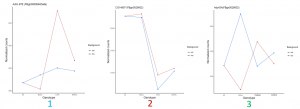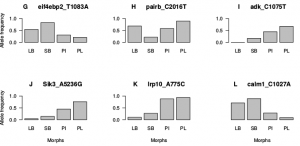Baldur and I attended a meeting on evolution of gene expression arranged by David Arnosti, Shinhan Shiu and colleagues.
Evolution and Core Processes in Gene Expression
May 9–12, 2019 East Lansing, Mich.
Baldur and I ended up pooling our talks into one, as he only got a flash talk and presented a poster.
Thus we presented the data from the transcriptome analyses of Ian Dworkin and Sudarshan Charis wing defect compensation experiment.
BioRxiv preprint: Compensatory evolution via cryptic genetic variation: Distinct trajectories to phenotypic and fitness recovery. Sudarshan Chari, Christian Marier, Cody Porter, Emmalee Northrop, Alexandra Belinky, Ian Dworkin. doi: https://doi.org/10.1101/200725
The titles of the abstracts Baldur and I submitted were Transcriptome changes after compensatory selection suppressed the phenotypic effects of two antagonizing developmental genes and Overcoming deleterious mutations at transcript level: Full length transcript expression in vg1 mutant flies restored by compensatory selection.
We are still working on the manuscripts.
The figure below is an example from the analyses of net and rhomboid compensatory evolution.
New preprint on BioRxiv. Extensive genetic divergence between recently evolved sympatric Arctic charr morphs
View ORCID Profile Jóhannes Guđbrandsson, Kalina H. Kapralova, Sigríđur Rut Franzdóttir, Thóra Margrét Bergsveinsdóttir, Völundur Hafstađ, Zophonías O. Jónsson, Sigurđur S. Snorrason, Arnar Pálsson
The availability of diverse ecological niches can promote adaptation of trophic specializations and related traits, as has been repeatedly observed in evolutionary radiations of freshwater fish. The role of genetics, environment and history in ecologically driven divergence and adaptation, can be studied on adaptive radiations or populations showing ecological polymorphism. Salmonids, especially the Salvelinus genus that includes Arctic charr (Salvelinus alpinus), are renowned for both phenotypic diversity and polymorphism. Arctic charr invaded Icelandic streams during the glacial retreat (about 9,000 to 12,000 years ago) and exhibits many instances of sympatric polymorphism. Particularly well studied are the four morphs in Lake Þingvallavatn in Iceland. The small benthic (SB), large benthic (LB), planktivorous (PL) and piscivorous (PI) charr differ in many regards, including size, form and life history traits. To investigate relatedness and genomic differentiation between morphs we extracted variants from developmental transcriptome data from three of those morphs, and verified 22 variants in population samples. The data reveal genetic differences between the morphs, with the two benthic morphs being more similar and the PL-charr more genetically different. The markers with high differentiation map to all linkage groups, suggesting ancient and pervasive genetic separation of these three morphs. No marker associated fully with morph, suggesting polygenic basis of traits separating them. Furthermore, gene ontology analyses suggest differences in collagen metabolism, odontogenesis and sensory systems between PL-charr and the benthic morphs. Genotyping in population samples from all four morphs confirms the genetic separation and indicates that the PI-charr are less genetically distinct than the other three morphs. The genetic separation of the other three morphs indicates certain degree of reproductive isolation. The extent of gene flow between the morphs and the nature of reproductive barriers between them remain to be elucidated.

One of the preliminary data for the paper, several markers differentiate the four morphs.
Differential gene expression during early development in recently evolved and sympatric Arctic charr morphs.
Jóhannes Guðbrandsson, Sigríður Rut Franzdóttir, Bjarni Kristófer Kristjánsson, Ehsan Pashay Ahi, Valerie Helene Maier, Kalina H. Kapralova, Sigurður Sveinn Snorrason, Zophonías Oddur Jónsson, Arnar Pálsson
Published in PeerJ.
Phenotypic differences between closely related taxa or populations can arise through genetic variation or be environmentally induced, leading to altered transcription of genes during development. Comparative developmental studies of closely related species or variable populations within species can help to elucidate the molecular mechanisms related to evolutionary divergence and speciation. Studies of Arctic charr (Salvelinus alpinus) and related salmonids have revealed considerable phenotypic variation among populations and in Arctic charr many cases of extensive variation within lakes (resource polymorphism) have been recorded. One example is the four Arctic charr morphs in the ∼10,000 year old Lake Thingvallavatn, which differ in numerous morphological and life history traits. We set out to investigate the molecular and developmental roots of this polymorphism by studying gene expression in embryos of three of the morphs reared in a common garden set-up. We performed RNA-sequencing, de-novo transcriptome assembly and compared gene expression among morphs during an important timeframe in early development, i.e., preceding the formation of key trophic structures. Expectedly, developmental time was the predominant explanatory variable. As the data were affected by some form of RNA-degradation even though all samples passed quality control testing, an estimate of 3 0 -bias was the second most common explanatory variable. Importantly, morph, both as an independent variable and as interaction with developmental time, affected the expression of numerous transcripts. Transcripts with morph effect, separated the three morphs at the expression level, with the two benthic morphs being more similar. However, Gene Ontology analyses did not reveal clear functional enrichment of transcripts between groups. Verification via qPCR confirmed differential expression of several genes between the morphs, including regulatory genes such as AT-Rich Interaction Domain 4A (arid4a) and translin (tsn). The data are consistent with a scenario where genetic divergence has contributed to differential expression of multiple genes and systems during early development of these sympatric Arctic charr morphs.
Sent to a PeerJ near you.
Differential gene expression during early development in recently evolved and sympatric Arctic charr morphs
Jóhannes Guðbrandsson, Sigríður Rut Franzdóttir, Bjarni Kristófer Kristjánsson, Ehsan Pashay Ahi, Valerie Helene Maier, Sigurður Sveinn Snorrason, Zophonías Oddur Jónsson, Arnar Pálsson
Phenotypic differences between closely related taxa or populations can arise through genetic variation or be environmentally induced, in both cases leading to altered transcription of genes during the structural and functional development of the body. Comparative developmental studies of closely related species or variable populations of the same species can help to elucidate the molecular mechanisms related to population divergence and speciation. Studies of Arctic charr (Salvelinus alpinus) and related salmonids have revealed considerable phenotypic variation among populations and in Arctic charr many cases of extensive variation within lakes (resource polymorphism) have been recorded. One example is the four Arctic charr morphs in the ~10.000 year old Lake Thingvallavatn, which differ in numerous morphologicaland life history traits. We set out to investigate the molecular and developmental roots of this polymorphism by studying gene expression in embryos of three of the morphs reared in a common garden set-up. We performed RNA-sequencing, de-novo transcriptome assembly and compared gene expression among morphs during a timeframe in early development.
Expectedly, developmental time was the predominant explanatory variable. As the data were affected by RNA-degradation, an estimate of 3’-bias was the second most common explanatory variable. Morph, both as a independent variable and as interaction with developmental time, affected the expression of numerous transcripts. The majority of transcripts with significant morph effects separated the limnetic and the benthic morphs. However, gene ontology analyses did not reveal clear functional enrichment of transcripts between groups. Verification via qPCR confirmed differential expression of several genes between the morphs, including regulatory genes such as Arid4a and Tsn. The data are consistent with a scenario where genetic divergence has contributed to differential expression of multiple genes and systems during early development of these sympatric Arctic charr morphs.
Valgerdur Andresdottir got me to help her with analyses for her master students project on MV virus evolution. The manuscript got resubmitted late winter, lets hope we managed to respond appropriately to the reviewers remarks.
Hallgrímur Arnarson, Arnar Pálsson, Margrét Gudnadóttir and Valgerdur Andrésdóttir. Maedi-visna virus persistence: Antigenic variation and latency.
Sophie S Steinhäuser, Ólafur S Andrésson, Arnar Pálsson, Silke Werth Fungal and cyanobacterial gene expression in a lichen symbiosis: Acclimatization and adaptation to temperature and habitat
Accepted in Fungal Biology.
The capacity of species to cope with variation in the physical environment, e.g. in temperatures and temperature fluctuations, can limit their spatial distribution. Organisms have evolved cellular mechanisms to deal with damaging effects of increased temperature and other aggravation, primarily through complex molecular mechanisms including protein refolding and DNA repair. It is of interest to see whether these responses vary with geographic location, with high vs. low elevation and on the coast vs. inland, indicating longterm acclimatization or genetic adaptation. As mutualistic symbioses, lichens offer the possibility of analyzing molecular stress responses in a particularly tight interspecific relationship. For this study, we have chosen the widespread cyanolichen Peltigera membranacea, a key player in carbon and nitrogen cycling in terrestrial ecosystems at northern latitudes. We ask whether increasing temperature is reflected in mRNA levels of selected damage control genes, and do the response patterns show geographical associations? Using real-time PCR quantification of 38 transcripts, differential expression was demonstrated for nine cyanobacterial and nine fungal stress response genes (plus the fungal symbiosis-related lec2 gene) when the temperature was increased from 5°C to15°C and 25°C. Principle component analysis (PCA) revealed two gene groups with different response patterns. Whereas a set of cyanobacterial DNA repair genes and the fungal lec2 (PC1 group) showed an expression drop at 15°C vs. 5°C, most fungal candidates (PC2 group) showed increased expression at 25°C vs. 5°C. PC1 responses also correlated with elevation. The correlated downregulation of lec2 and cyanobacterial DNA repair genes suggests a possible interplay between the symbionts warranting further studies.
Sorry, this entry is only available in Icelandic.
Sorry, this entry is only available in Icelandic.
Johannes Gudbrandsson1, Ehsan P. Ahi1, Sigridur R. Franzdottir1, Kalina H. Kapralova1, Bjarni K. Kristjansson2, S. Sophie Steinhaeuser1, Valerie H. Maier1, Isak M. Johannesson1, Sigurdur S. Snorrason1, Zophonias O. Jonsson1, Arnar Palsson1
Species and populations with parallel evolution of specific traits can help illuminate how predictable adaptations and divergence are at the molecular and developmental level. Following the last glacial period, dwarfism and specialized bottom feeding morphology evolved rapidly in several landlocked Arctic charr Salvelinus alpinus populations in Iceland.
Continue reading 'Revised: The developmental transcriptome of contrasting Arctic charr (Salvelinus alpinus) morphs'»
Sorry, this entry is only available in Icelandic.

